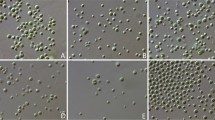Abstract
Light-microscopic and electron-microscopic studies of the tropical marine sponge Haliclona sp. (Order: Haplosclerida; Family: Haliclonidae) from Heron Island, Great Barrier Reef, have revealed that this sponge is characterized by the presence of dinoflagellates and by nematocysts. The dinoflagellates are 7–10 μm in size, intracellular, and contain a pyrenoid with a single stalk, whereas the single chloroplast is branched, curved, and lacks grana. Mitochondria are present, and the nucleus is oval and has distinct chromosomal structure. The dinoflagellates are morphologically similar to Symbiodinium microadriaticum, the common intracellular symbiont of corals, although more detailed biochemical and molecular studies are required to provide a precise taxonomic assignment. The major sponge cell types found in Haliclona sp. are spongocytes, choanocytes, and archaeocytes; groups of dinoflagellates are enclosed within large vacuoles in the archaeocytes. The occurrence of dinoflagellates in marine sponges has previously been thought to be restricted to a small group of sponges including the excavating hadromerid sponges; the dinoflagellates in these sponges are usually referred to as symbionts. The role of the dinoflagellates present in Haliclona sp. as a genuine symbiotic partner requires experimental investigation. The sponge grows on coral substrates, from which it may acquire the nematocysts, and shows features, such as mucus production, which are typical of some excavating sponges. The cytotoxic alkaloids, haliclonacyclamines A and B, associated with Haliclona sp. are shown by Percoll density gradient fractionation to be localized within the sponge cells rather than the dinoflagellates. The ability to synthesize bioactive compounds such as the haliclonacyclamines may help Haliclona sp. to preserve its remarkable ecological niche.
Similar content being viewed by others
Author information
Authors and Affiliations
Additional information
Received: 6 May 1997 / Accepted: 19 February 1998
Rights and permissions
About this article
Cite this article
Garson, M., Flowers, A., Webb, R. et al. A sponge/dinoflagellate association in the haplosclerid sponge Haliclona sp.: cellular origin of cytotoxic alkaloids by Percoll density gradient fractionation. Cell Tissue Res 293, 365–373 (1998). https://doi.org/10.1007/s004410051128
Issue Date:
DOI: https://doi.org/10.1007/s004410051128




